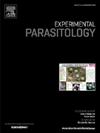In vivo study of nano chitosan beads-based ELISA versus traditional sandwich ELISA for the early diagnosis of trichinosis
IF 1.6
4区 医学
Q3 PARASITOLOGY
引用次数: 0
Abstract
Human trichinosis is a serious foodborne parasitic zoonosis. Diagnosing human trichinosis is usually difficult due to the nonspecific clinical picture and the limited effectiveness of serological tests in acute infections. While ELISA can detect circulating Trichinella antigens, aiding in early diagnosis, its sensitivity may be low. The application of nanoparticles can improve the sensitivity of ELISA and allow a specific early diagnosis of the disease. This work compares the nano chitosan beads-based ELISA (NCSB-ELISA) and traditional sandwich ELISA for the detection of circulating Trichinella spiralis (T. spiralis) crude extract-antigen (CEA) in serum samples of experimentally infected mice.
Fifty-seven mice included in this study were classified into 3 groups: T. spiralis infected group (Group I) (36 mice), which was equally subdivided into six subgroups according to the time of sacrifice (6, 8, 10, 12, 14 and 16) days post-infection (dpi), cross-reactivity group (Group II) (9 mice) and negative control group (Group III) (12 mice). T. spiralis AW-CEA prepared from the adult worms were used to produce anti- T. spiralis IgG-polyclonal antibodies in rabbits; these antibodies were utilized to detect AW-CEA in serum samples by traditional sandwich ELISA and NCSB-ELISA. Using NCSB-ELISA, T. spiralis AW-CEA was detected in sera collected at 8 dpi, with a sensitivity of 50% and a specificity of 100%. Meanwhile, traditional sandwich ELISA could not detect the antigen at the same time interval. Both ELISA were able to detect the antigen in samples collected at 10, 12, 14 and 16 dpi with a sensitivity of 16.67%, 50%, 67.67% and 83.67%, respectively, for traditional sandwich-ELISA and a specificity of 100% at 10, 12 and 14 dpi while at 16 dpi specificity was decreased to 90.91%. In contrast, the sensitivity of NCSB-sandwich ELISA on the same days was 66.67%, 83.34%, 100% and 100%, respectively, with a specificity of 100% at all days. False positive detection of T. spiralis AW-CEA in the serum of mice in GII was recorded on day 16 pi by only traditional sandwich ELISA.
This study concluded that NCSB-ELISA is a promising and sensitive technique for the early and specific diagnosis of acute trichinosis in an animal model.

基于纳米壳聚糖珠的酶联免疫吸附试验与传统夹心酶联免疫吸附试验早期诊断旋毛虫病的体内研究。
人旋毛虫病是一种严重的食源性寄生虫病。诊断人类旋毛虫病通常是困难的,由于非特异性的临床表现和有限的有效性的血清学测试在急性感染。虽然ELISA可以检测循环旋毛虫抗原,有助于早期诊断,但其敏感性可能较低。纳米颗粒的应用可以提高酶联免疫吸附试验的敏感性,并允许对疾病进行特异性的早期诊断。比较了纳米壳聚糖珠型酶联免疫吸附试验(NCSB-ELISA)和传统夹心酶联免疫吸附试验(sandwich ELISA)检测实验感染小鼠血清中循环旋毛虫(T. spiralis)粗提物抗原(CEA)的效果。将57只小鼠分为3组:螺旋体感染组(I组)(36只),根据感染后(dpi)牺牲时间(6、8、10、12、14、16)分为6个亚组,交叉反应组(II组)(9只)和阴性对照组(III组)(12只)。利用螺旋螺旋体成虫制备的AW-CEA制备抗螺旋螺旋体igg多克隆抗体;采用传统夹心ELISA和NCSB-ELISA检测血清样品中的AW-CEA。采用NCSB-ELISA法,在8 dpi采集的血清中检测螺旋锥虫au - cea,灵敏度为50%,特异性为100%。同时,传统的夹心ELISA不能在相同的时间间隔内检测到抗原。两种ELISA技术在10、12、14和16 dpi时均能检测到抗原,灵敏度分别为16.67%、50%、67.67%和83.67%,传统的三明治ELISA在10、12和14 dpi时特异性为100%,而在16 dpi时特异性降至90.91%。NCSB-sandwich ELISA在同一天的敏感性分别为66.67%、83.34%、100%和100%,全天特异性均为100%。采用传统夹心酶联免疫吸附试验(sandwich ELISA),于第16天检测出GII小鼠血清中螺旋螺旋体α - cea的假阳性。本研究表明,NCSB-ELISA是一种有前景的、灵敏的急性旋毛虫病动物模型早期特异性诊断技术。
本文章由计算机程序翻译,如有差异,请以英文原文为准。
求助全文
约1分钟内获得全文
求助全文
来源期刊

Experimental parasitology
医学-寄生虫学
CiteScore
3.10
自引率
4.80%
发文量
160
审稿时长
3 months
期刊介绍:
Experimental Parasitology emphasizes modern approaches to parasitology, including molecular biology and immunology. The journal features original research papers on the physiological, metabolic, immunologic, biochemical, nutritional, and chemotherapeutic aspects of parasites and host-parasite relationships.
 求助内容:
求助内容: 应助结果提醒方式:
应助结果提醒方式:


